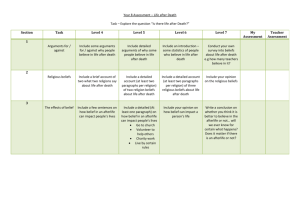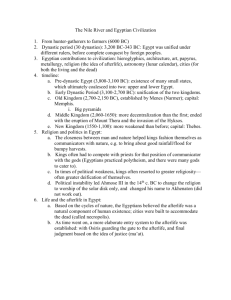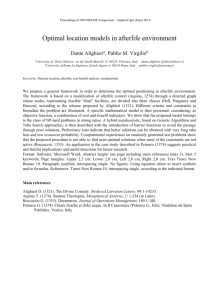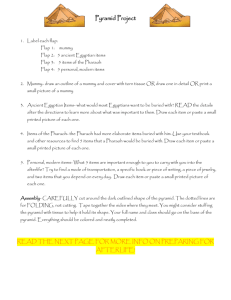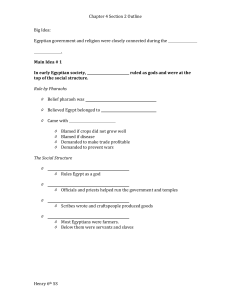DEATH AND AFTERLIFE
advertisement
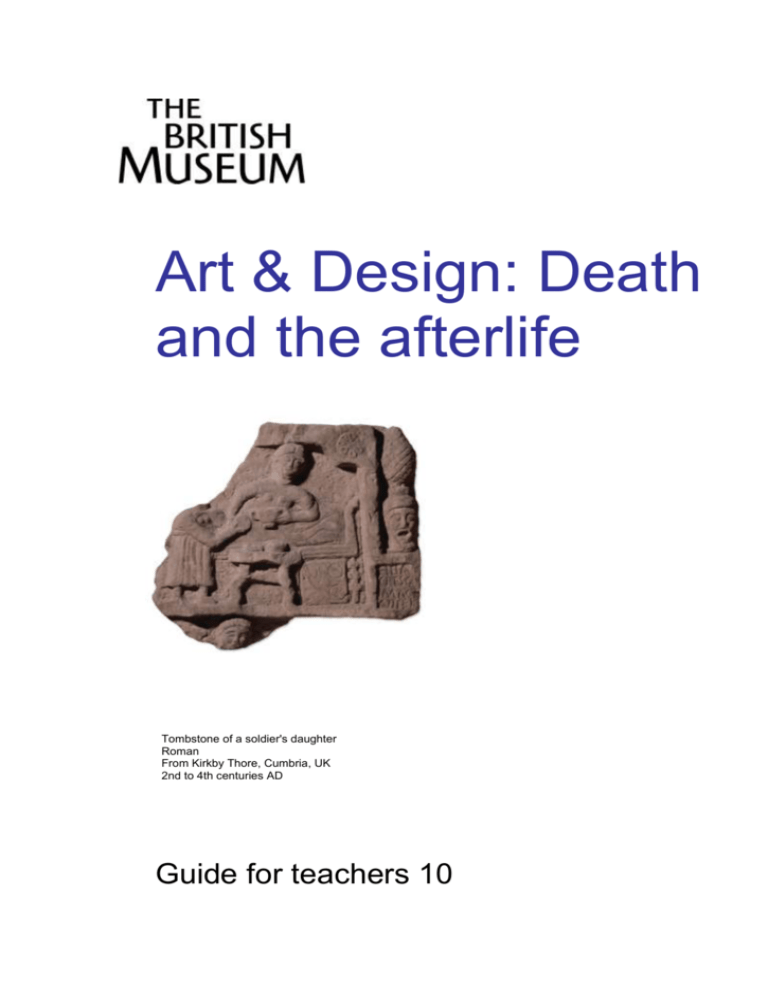
Art & Design: Death and the afterlife Tombstone of a soldier's daughter Roman From Kirkby Thore, Cumbria, UK 2nd to 4th centuries AD Guide for teachers 10 Art and Design: Death and the afterlife Introduction Art & Design guides for teachers The collections of the British Museum have inspired artists for hundreds of years and are a rich source of ideas and stimulation for teachers and students alike. This series of ten guides is intended to help primary and secondary teachers to use the objects in the British Museum collections for teaching art and design. This will support students’ research skills, knowledge and understanding in order to make their practical work more meaningful and contextualised. Each guide focuses on a topic. Each topic is analysed through four or five themes, each of which is illustrated with a museum object, from different historical periods and world cultures. These topics, themes and objects have been specially chosen so that you and your students can use them as starting points to explore the collections further, either at the Museum or online. Each guide ends with points for classroom discussion and brief ideas for starting off activities and projects. The guides in the series are: 1 Containers 2 Sculpture 3 Textiles 4 Symbols 5 Celebration 6 The Natural World 7 Identity 8 Gods and spirits 9 Objects in motion 10 Death and the afterlife All the objects have been taken from the Museum’s online database, available through: www.britishmuseum.org/explore/introduction.aspx. There you can find high quality images which can be copied into your own presentations for the classroom or for students to download. Contextual understanding In order to develop their critical thinking, students should examine the following when considering any museum object: Origin: Materials: Process: Function: Meaning: Who made it? Where and when was it made? What is it made from? How was it made? What was it used for? What does it mean? Once students have understood the context, they can analyse the form and decoration of the object which are usually determined or influenced by all these aspects. . Art and Design: Death and the afterlife Introduction World cultures The guides are not based around a particular cultural or geographical region. If you wish to focus your study on, for example, objects from Africa then use the list below, where the guides which contain objects from particular regions have been grouped. Africa Death and the afterlife, Gods and spirits, Identity, Sculpture, Symbols, Textiles, The Americas Celebration, Containers, Gods and spirits, Symbols, Textiles, Natural World Asia Celebration, Containers, Death and the afterlife, Gods and spirits, Objects in motion, Sculpture, Europe Celebration, Containers, Death and the afterlife, Gods and spirits, Identity, Objects in motion, Sculpture, Textiles, Natural World Middle East Gods and spirits, Sculpture, Natural World Oceania Containers, Death and the afterlife, Gods and spirits, Sculpture, Symbols, Natural World Cross-curricular topics Citizenship Many of these topics tap into citizenship themes such as local and national identity, globalisation and global issues, and the impact of the media. History The objects are from a variety of historical contexts and periods. Research and discussions about the use of clothing for status and the importance of symbols are central to exploring images as evidence in history. Geography Examining objects from specific cultures is an excellent way of understanding how humans interact and cope with living and surviving in different environments. Religious Education Many of these objects have some spiritual significance. Those relating to the afterlife and deities are ideal starting points for considering similarities and differences in belief systems. . Art and Design: Death and the afterlife Themes Death and Afterlife Most cultures have beliefs about death and the afterlife and produce objects that relate to these beliefs. Some peoples create sculptures that are intended to help bid farewell, honour the dead or keep the memory of ancestors alive. Others have complex beliefs about an afterlife and produce objects that might be used in the next world or assist in the journey there. Beliefs about death and the afterlife also affect the way a body is treated after death and how it is buried. Many cultures build tombs to protect the body that might also contain objects to demonstrate the power and wealth of the deceased. Objects linked to beliefs about death and afterlife might also have played a part in complex rituals. In these examples we explore objects relating to beliefs and practices about death and afterlife from different cultures. Immortality Like many peoples, the ancient Egyptians believed that death was not the end of life, but a transition to a new one. After death, each person undertook a perilous journey to the land of the dead where they were judged and if lucky, reborn into the afterlife. For the wealthy this led to complex burial rituals that aimed to ensure immortality. The body needed to be kept intact so the soul would have a place to live after death. It was therefore mummified and placed inside coffins for protection. This gilded cedar wood outer coffin contained the body of Henutmehyt, an aristocratic Egyptian woman. Typically the coffin is in the shape of a standing figure and shows an idealized image of the dead woman in her elaborate wig. Many of the decorations are symbolic and were intended to ensure the deceased’s rebirth and wellbeing in the afterlife. Beneath the collar two wedjat eyes ward of the evil eye and the sky-goddess Nut speads her wings protectively over the body. Lower down are figures of the Four Sons of Horus, guardians of the internal organs. Art and Design: Death and the afterlife Themes Honouring the ancestors In many cultures the dead are not simply buried and forgotten. Rather they are considered powerful forces and rituals are held to honour their memory and send them on their way. The Asmat people of New Guinea hold a ceremony called the jipae where the living honour and say farewell to departed ancestors. During the ceremony performers wear woven masks of string and sago palms leaves, such as the one illustrated. The masks cover the body and the performers impersonate a particular person who has died since the last ceremony. Afterwards the performer takes on the dead person's responsibilities, including bringing up their children. This means that the spirits of the dead can see their families are being well looked after. They can therefore leave the world of the living in peace and take their place in the world of the dead. Sacred body parts In the European Middle Ages it was believed that a saint’s soul went to heaven on death. There he or she could intercede on behalf of the faithful. However, their physical body parts or relics were carefully preserved as they were believed to be holy and have magical healing powers. They were often encased in precious containers or reliquaries and displayed in churches. Their veneration was an important part of Medieval Christian worship and pilgrims made long journeys to shrines containing relics, to pray for their souls and ask for cures. This life size reliquary of St Eustace, in the form of an idealised head, contains fragments of the saint’s skull. It originally came from the Cathedral Treasury in Basel, Switzerland and might have been displayed on an altar. It has large staring eyes which invite communication and suggest the powerful presence of the saint watching over the community. Art and Design: Death and the afterlife Themes Grave gifts for the afterlife Like the ancient Egyptians, the ancient Chinese believed that the world they passed into after death was similar to the living world. They were therefore buried with objects and models of things they had used in their earthly lives. This glazed ceramic bowl depicts a pond with a large tree in the middle. The pond contains fish and frogs, whilst ducks and a tortoise sit on the rim. A man is catching fish in an imaginary net and two men are shooting birds out of the tree. Perhaps the owner particularly enjoyed the pleasures of hunting and fishing and wanted to continue enjoying these pursuits in the world beyond. The bowl probably comes from the tomb of an ordinary working person, such as a farmer, rather than a wealthy member of the aristocracy. Such tombs contained models representing ordinary people’s daily lives such as replicas of buildings, carts or farmyards of animals. The wealthy and powerful were buried with different types of objects that were intended to maintain their rank, status and lifestyle in the next world. Tomb figures of soldiers, evoking military power, were buried with emperors or generals and the burial goods of nobility might include ceramic models of servants and entertainers, so they could continue to enjoy the banquets and festivities of their mortal lives. Art and Design: Death and the afterlife Activities and art projects General discussion Find out how different cultures have thought about and represented the life after death or the afterlife. What is it like and what are similarities and differences in the way it is imagined? Is it a place someone would like to be or not? Consider the different ways the physical body is treated after death. Is it preserved and if so, how and in what? Or is it left to perish? What beliefs do these practices reflect? Are the bodies of ordinary people treated differently from those of the rich, powerful or saintly? How common is pilgrimage to the bodies of the dead? Research different cultures where such pilgrimage is important. What are the similarities and differences? How do we deal with death in our culture? Consider the issues around death and the afterlife in contemporary society. What other types of objects can you find on the British Museum website and elsewhere that relate to beliefs about death and afterlife? Projects and activities Primary Documenting the afterlife Focus on one culture’s mythology of the afterlife. What is it like and are there different places or areas? What happens and who are the different characters one might meet? With the whole class make a frieze round the walls of the class room that depicts an individual’s journey through this world - look at other types of frieze to help, e.g. the Bayeux Tapestry, Assyrian friezes or the Parthenon frieze. Or you could divide the class into groups and get each group to produce a frieze exploring different visions of the afterlife. Make a grave stone Design and produce a grave stone for a historical or fictional character. Decorate it with symbols that relate to their identity. Art and Design: Death and the afterlife Activities and art projects Secondary Art of the dead Explore the ways different cultures, including our own, remember the dead and consider their traditions of memorial. Why is it thought important to remember the dead? Research the way contemporary artists, such as Christian Boltanski, Susan Hiller or Damien Hirst have made work about this theme. Produce your own memorial to a person or historical event. Attitudes to Death Explore how and why, in contemporary Western society we attempt to deny death and prolong life through things like medicine and plastic surgery. Are we trying to create the perfect afterlife in this life? How do our traditions compare with those of traditional societies? What sort of object would the students design to explore contemporary Western attitudes to death? Art and Design: Death and the afterlife Illustrations Gilded outer coffin of Henutmehyt from the tomb of Henutmehyt Thebes, Egypt 19th Dynasty, around 1250 BC height: 2m x width 59 cm Jipae mask Asma people from Momogo village, Upper Pomatsj River, Papua Barat, New Guinea collected in 1961 height 1.88 m Reliquary of St Eustace Basle, Switzerland AD 1210 height 32 cm Glazed pottery pond with figures China Eastern Han dynasty, AD 6-220 height 32.8 cm Illustrations
